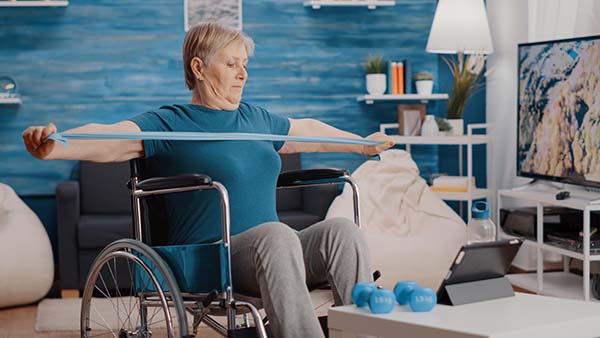It should come as no surprise that physical exercise is an important part of taking care of yourself that has significant health benefits to the mind, body, and heart, no matter what physical condition you are in or how old you are.
As a matter of fact, adults from ages 18 to 65, should be doing at least 150 to 300 minutes of moderate-intensity aerobic physical activities or at least 75 to 150 minutes of vigorous-intensity aerobics per week. For adults over the age of 65, the same recommendations are true, except older adults should also be adding exercise that emphasizes functional balance and strength training at moderate or greater intensity, on 3 or more days a week, to enhance functional capacity and to prevent falls.
Although unwelcome effects of the natural process of aging such as limited mobility or aching joints may discourage you from exercising or make you feel limited in the types of activities you can do, it doesn’t have to be that way. Whether you have a disability or limited mobility, there are still ways that you can get active, strengthening your body and boosting your mood.
Strength Training Exercises While Sitting
Strength training is not only a great way to strengthen the major muscles groups that are essential for performing everyday activities, but it also helps with the following:
- protects bone health and muscle mass that can decrease with age
- improves blood pressure
- reduces the risk of heart disease or hypertension
- can help with chronic disease management
- helps you develop better body mechanics such as coordination, balance, and posture.
 In fact, according to a review published in Aging Clinical and Experimental Research in November 2017, doing at least one resistance training session per week — performed alone or in a program with multiple different types of workouts — produced up to a 37 percent increase in muscle strength, a 7.5 percent increase in muscle mass, and a 58 percent increase in functional capacity (linked to risk of falls) in frail, elderly adults.
In fact, according to a review published in Aging Clinical and Experimental Research in November 2017, doing at least one resistance training session per week — performed alone or in a program with multiple different types of workouts — produced up to a 37 percent increase in muscle strength, a 7.5 percent increase in muscle mass, and a 58 percent increase in functional capacity (linked to risk of falls) in frail, elderly adults.
Even if you are restricted to a wheelchair or have trouble standing for long periods of time, you can do several strength training exercises while seated using weights, resistance bands, or simply resisting the weight of your own body that will strengthen the targeted muscle groups. Some examples of exercises you can do include arm circles or arm lifts using your own body weight; arm exercises using weights or resistance bands; and leg exercises with ankle weights, resistance bands, or resisting body weight that strengthen your legs, core, and abdominal muscles.
Stretching from Your Seat
Stretching is another great form of exercise you can do while seated that has the following benefits:
- Improves performance in physical activities, as well as posture
- Increases flexibility, range of motion, and blood flow to muscles
- Helps heal and prevent back pain
Some examples of stretches that you can do with limited mobility include stretching your arms across your chest, rotating your hips, stretching out your legs, stretching your shoulders, rotating your neck, and more. No matter what your mobility limitations are, there are many stretches you can do.
Cardio in a Chair
Cardiovascular exercise has many benefits such as:
- Lowering blood pressure
- Reducing chronic pain, asthma symptoms, and risk of falling
- Regulating weight and blood sugar
- Strengthening heart and lungs, brain power, and immune system
- Aiding sleep
Whether you are in a wheelchair or have limited mobility, many cardio exercises can be modified for someone with mobility restrictions. For example, people can do activities such as boxing, playing basketball, or even wheeling around the park at a brisk pace. Swimming is another good cardio option for people with mobility restrictions, as it takes the weight off your body and pressure off your joints, allowing you to comfortably get your heart rate up. Call your local gym to see what modifications can be made to cardio exercises or classes that you are interested in, according to your mobility limits.
Increase Mobility and Become More Active with an Acorn Stairlift
Finally, one of the most important parts of getting active with limited mobility is being able to move up and down the stairs freely, having access to all parts of your home, inside and out. This allows you to have access to the resources you need to improve your health such as the outdoors, exercise equipment, your workout room, and a gym. Every eight minutes, somewhere in the world, Acorn Stairlifts installs a stairlift into someone’s home, helping them regain their independence, health, and happiness. Allow Acorn Stairlifts to lift your life with a stairlift so that you can start living your life to the fullest. Click here to get a free, no-obligation quote and home survey and improve your health and the overall quality of your life.

